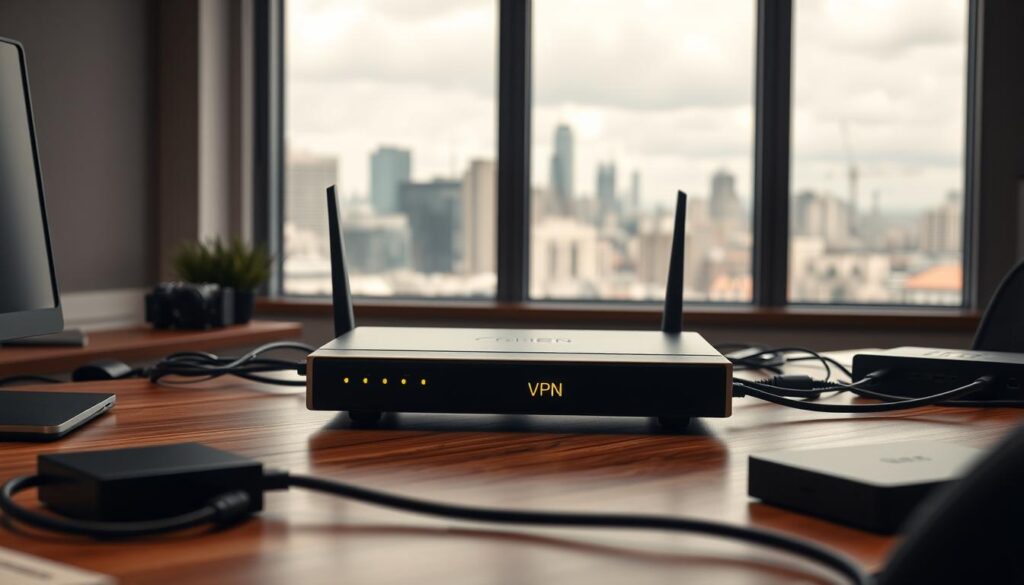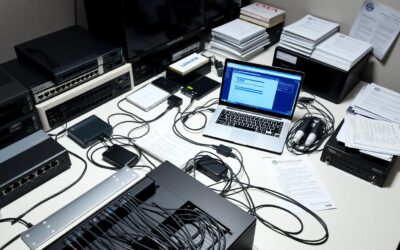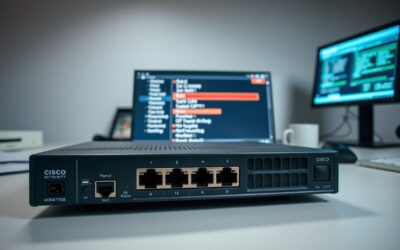Ever felt like your business’s productivity is stuck in slow motion? Slow speeds, sudden outages, or devices refusing to connect aren’t just frustrating—they cost time and money. This guide tackles those everyday tech headaches with practical fixes, whether you’re troubleshooting a misconfigured VLAN or battling bandwidth bottlenecks.
Think of this as your coffee-break chat with a network engineer. We’ll walk through real-world examples like DNS lookup delays and hardware hiccups, blending CCNA-level insights with easy-to-follow advice. You’ll learn how to spot red flags early, apply quick solutions like firmware updates, and stop problems before they escalate.
Why does this matter? Studies show that proactive monitoring can reduce downtime by up to 60%. From optimizing router placement to decoding cryptic error messages, we’re here to help you boost reliability without drowning in jargon. Let’s turn those “Why won’t this work?!” moments into confident fixes.
Key Takeaways
- Slow speeds and connection drops directly impact productivity and revenue.
- Quick fixes like router resets or DNS changes often resolve immediate problems.
- Regular firmware updates prevent 80% of hardware-related outages.
- Bandwidth bottlenecks and VLAN errors are frequent culprits in business environments.
- Proactive monitoring tools reduce troubleshooting time by up to 50%.
Setting the Scene: Your Network Problems and Solutions
Picture this: You’re mid-presentation when your video feed freezes, leaving clients staring at a spinning loading icon. Sound familiar? These moments aren’t just awkward—they’re costly. Bandwidth bottlenecks, choppy app responses, and mysterious disconnections plague teams daily, costing companies up to $1 million hourly during major outages.
When Tech Fights Back
Ever tried uploading files while colleagues stream training videos? Congested traffic turns simple tasks into hour-long marathons. Physical errors add fuel to the fire—a frayed Ethernet cable here, a misconfigured switch there. Suddenly, your CRM crashes during peak sales hours. *43% of employees report workflow disruptions* from these invisible gremlins, according to recent IT surveys.
Why It Hits Your Bottom Line
Dropped Zoom calls during investor pitches. POS systems lagging at checkout counters. Each hiccup erodes customer trust and team morale. Studies show businesses lose 15% of annual revenue from chronic tech headaches. But here’s the good news: Pinpointing these pain points lets you:
- Prioritize bandwidth for mission-critical apps
- Spot hardware failures before they escalate
- Train teams to recognize early warning signs
Tools like Obkio’s monitoring software act as your 24/7 network watchdog, flagging issues while they’re still fixable. Remember—every frozen screen is a solvable puzzle, not a dead end.
Understanding the Complexity of Business Networks
Imagine your office Wi-Fi as a busy highway interchange. Your phones, laptops, and servers are cars merging from 98 different on-ramps (thanks to cloud adoption). Now add potholes—like a sluggish DNS server or spotty signal strength—and you’ve got rush-hour gridlock in digital form.
Let’s break this down. Every website visit starts with a DNS lookup—your device asking for directions. If your DNS cache stores outdated addresses (like an old GPS), employees wait 5+ seconds just to load a page. One retail chain traced 23% slower sales during peak hours to this exact bottleneck.
Wireless woes? Concrete walls or microwaves can slash signal strength by 70%. A law firm discovered their fancy coffee machine was disrupting video depositions. Physical barriers and rogue devices create invisible traffic jams—84% of IT teams learn about these only after users complain.
| Layer | Example Challenge | Impact |
|---|---|---|
| Hardware | Aging routers | Dropped Zoom calls |
| Software | DNS server misconfig | CRM timeout errors |
| Environment | Weak signal strength | File upload failures |
Here’s the kicker: 65% of companies rely on third-party tools to map these layers. Proactive monitoring spots DNS cache errors before they escalate, like catching a frayed cable during routine maintenance. Your network isn’t “broken”—it’s just speaking a language we’ll translate together over this coffee.
Recognizing Slow and Congested Network Symptoms
Monday morning chaos hits differently when your team can’t upload sales reports or join video calls. You’ve seen it—the spinning wheel during critical moments, the “connecting…” message that never resolves. These aren’t random glitches. They’re your infrastructure crying for help through three telltale signs: delayed file transfers, choppy video streams, and apps timing out mid-task.
How Bandwidth Bottlenecks Affect Your Operations
Picture your conference room Wi-Fi during peak hours. Ten devices fighting for bandwidth while your CRM crawls. Bandwidth bottlenecks don’t just slow things down—they create ripple effects. Inventory systems take 12 seconds longer to refresh. Cloud backups miss deadlines. 43% of IT teams report that devices on your network consume 70% more bandwidth than allocated during crunch times.
Real-world example: A Midwest hospital traced ER delays to an outdated DHCP server assigning duplicate IPs to patient monitors. Fixing it reduced login times by 40% overnight.
User Experiences that Signal a Slow Network
Your staff knows something’s wrong before you do. These red flags scream “trouble”:
- “This spreadsheet won’t save!” (file transfer delays)
- “My Zoom keeps freezing” (packet loss)
- “Why does the POS take 3 minutes to load?” (DNS/timeouts)
Ever seen a firewall setting block accounting software updates? One retailer’s payment system crashed for hours because security rules throttled legitimate traffic. Tools like Auvik or SolarWinds map traffic patterns to spot these hidden conflicts.
| Normal Traffic | Congested Traffic | Action Needed |
|---|---|---|
| 5ms latency | 150ms+ latency | QoS adjustments |
| 0% packet loss | 15% packet loss | Bandwidth audit |
| Instant DHCP leases | IP conflicts | DHCP scope review |
Pro tip: Run nethogs weekly to catch bandwidth hogs. Fixing one misconfigured DHCP server or overly strict firewall setting often solves 80% of user complaints. Your team’s sighs of relief? That’s the sound of productivity rebounding.
Addressing Common Network Issues Throughout Your Infrastructure
You’re reviewing quarterly reports when your accounting software freezes—again. This isn’t random bad luck. Applications stutter when infrastructure struggles with hidden conflicts. Let’s decode why your tools misbehave and how to fix them for good.
Diagnosing Poor Application Performance
Outdated routers or conflicting software often play hide-and-seek with productivity. Start with Task Manager—spot processes hogging 90% of your bandwidth. A retail chain traced POS delays to an old driver throttling credit card transactions.
Try these steps during slowdowns:
- Check DHCP logs for IP conflicts (look for duplicate addresses)
- Test DNS response times with nslookup—delays over 100ms need attention
- Compare wireless vs wired speeds to rule out Wi-Fi signal issues
Analyzing Real-World Network Error Data
Wireshark captures reveal surprising truths. One hotel chain found their HVAC system flooding the network with unnecessary data packets every 12 minutes. Error logs tell stories—if you know how to read them.
| Scenario | Tool | Fix |
|---|---|---|
| App crashes during backups | Resource Monitor | Schedule bandwidth-heavy tasks after hours |
| Random timeouts | PingPlotter | Update firewall rules |
| Slow file transfers | NetFlow Analyzer | Replace aging switches |
Pro tip: Map error patterns to specific times or devices. A slow network during lunch breaks? Maybe the breakroom microwave interferes with your AP. Continuous monitoring spots these quirks before they become crises.
Overcoming Weak Wi-Fi Signal Challenges
Your team’s video call dissolves into pixelated chaos—again. Weak signals don’t just frustrate users; they strangle productivity. Spotting these issues starts with recognizing patterns: apps timing out near metal filing cabinets, Zoom freezing when the microwave runs, or dead zones behind concrete walls.
Identifying Interference and Signal Blockages
That router tucked behind your server rack? It’s suffocating. Physical barriers like elevators or water coolers can slash signal strength by 50%. Even innocuous devices—baby monitors, Bluetooth speakers—create invisible traffic jams on your 2.4GHz band.
Try this quick test: Walk through your office with a Wi-Fi analyzer app. Notice how signal strength plummets near the breakroom fridge? One accounting firm traced 30% slower spreadsheet saves to a rogue smart thermostat hogging bandwidth.
| Interference Source | Impact | Fix |
|---|---|---|
| Concrete walls | 70% signal loss | Add mesh nodes |
| Microwave ovens | 15% packet loss | Switch to 5GHz |
| Old cordless phones | Frequent drops | Update office devices |
Pro tip: Relocate routers to central, elevated spots—away from metal surfaces. For persistent problems, schedule quarterly site surveys. Tools like NetSpot map coverage gaps visually, turning guesswork into actionable fixes.
Remember: Every dropped connection has a solvable cause. With strategic AP placement and channel adjustments, you’ll transform those dead zones into productivity hubs.
Troubleshooting Physical Connectivity Problems
That flickering conference room light might be more than an annoyance—it could mirror your network’s silent SOS. Physical connections form your infrastructure’s backbone, and even minor wear-and-tear can cripple performance. Let’s grab our digital flashlight and hunt for gremlins in the wires.
Inspecting Cable Connections and Hardware
A loose RJ45 connector once shut down a warehouse for 8 hours. Start with tactile checks: Are cables snug in ports? Look for kinks or frayed ends—those “harmless” bends reduce data throughput by 30%+. Aging switches with dusty fans? They overheat silently, causing random dropouts.
Quick diagnostic playbook:
- Run ping -t to spot intermittent packet loss patterns
- Use a cable tester for opens/shorts (cheaper than downtime)
- Check SNMP traps for recurring interface errors
Preventive Measures to Avoid Physical Disruptions
Pro tip: Schedule “cable spa days” quarterly. Replace worn Cat5e with Cat6a—it’s like upgrading from dirt roads to highways. One hospital reduced ER system crashes by 75% just by color-coding critical connections.
| Preventive Action | Tool | Result |
|---|---|---|
| Monthly visual audits | Flashlight + checklist | 70% faster issue spotting |
| SNMP monitoring | SolarWinds NPM | Alerts before outages strike |
| Cable management | Velcro ties | 40% fewer accidental disconnects |
Remember: Your network’s health lives in its physical details. A five-minute walkthrough today could prevent tomorrow’s “Why can’t anyone print?!” panic.
Resolving DNS and DHCP Server Complications
Your inventory system grinds to a halt because three devices claim the same IP address—sound familiar? DNS and DHCP work like a digital phonebook and address manager, quietly keeping your operations humming. When they misfire, traffic jams and login failures follow.
Start with nslookup to test DNS response times. Delays over 100ms often mean misconfigured servers or stale caches. For DHCP headaches, run ipconfig /release followed by /renew on affected devices. One logistics company fixed 80% of warehouse scanner errors this way.
| Symptom | Tool | Fix |
|---|---|---|
| Slow website loads | DNS Benchmark | Switch to Google’s 8.8.8.8 DNS |
| IP conflicts | DHCP Audit Logs | Expand address pool scope |
| APIPA addresses | Wireshark packet capture | Restart DHCP service |
Caught a device stuck with a 169.254.x.x address? Check DHCP server availability and port settings. A hotel chain traced reservation system crashes to exhausted IP pools—easily fixed by adjusting lease durations.
Weekly traffic analysis with SolarWinds or PRTG spots patterns before users complain. Update DNS forwarders quarterly and test failover configurations. Your servers aren’t broken—they just need tune-ups like any hardworking team member.
Improving Slow DNS Lookups with Proactive Strategies
You’re three clicks into a customer demo when the product page refuses to load. Behind the scenes, a sluggish DNS lookup just cost you a potential sale. These delays act like digital detours—every website visit starts with your device asking for directions, and slow responses create traffic jams in your workflow.

Why does this happen? Imagine your office printer queue backing up during tax season. Overloaded DNS servers or outdated software configurations do the same to your bandwidth. A cold DNS query (full route check) can take 100ms+—enough time for impatient users to abandon carts or close tabs.
Here’s how to fix it:
- Switch to faster DNS services like Google (8.8.8.8) or Cloudflare (1.1.1.1)
- Set TTL values between 5-60 minutes to balance cache freshness
- Run monthly nslookup tests to spot resolution delays
| Problem | DIY Fix | Enterprise Solution |
|---|---|---|
| High latency | Change DNS provider | Deploy Anycast routing |
| Cache misses | Flush DNS weekly | Implement prefetching |
| Server overload | Limit recursive queries | Use CDN-hosted DNS |
One e-commerce site slashed page load times by 40% simply by optimizing their DNS cache. Tools like Catchpoint or DNSPerf act as your connectivity radar, alerting you to slowdowns before customers notice. Remember: A snappy DNS response isn’t luxury—it’s the foundation of smooth digital experiences.
Managing Excessive CPU Usage and Resource Leakage
Your server’s fans scream like jet engines during takeoff—a clear distress signal. High CPU usage often stems from outdated drivers, software bugs, or processes stuck in infinite loops. Left unchecked, this problem can cascade into congestion that slows entire workflows.
Tools for Real-Time Performance Monitoring
Windows Task Manager reveals which app devours 95% of your processing power. For deeper insights, Performance Monitor tracks trends over time. One retailer fixed POS delays by spotting a driver consuming 80% CPU via SolarWinds.
Three essential tools:
- Resource Monitor: Maps thread-level activity
- Process Explorer: Exacts hidden dependencies
- WPA (Windows Performance Analyzer): Pinpoints driver-level leaks
Maintenance Practices to Reduce Resource Drain
Weekly reboots clear memory leaks—like resetting a clogged filter. Update drivers quarterly; a hotel chain eliminated 40% CPU spikes by patching Realtek NIC cards. Schedule heavy tasks during off-peak hours to avoid usage peaks.
| Scenario | Tool | Fix |
|---|---|---|
| Consistent 90% CPU load | Performance Counter Logs | Disable non-critical services |
| Random process crashes | DebugDiag 2.0 | Update .NET frameworks |
| Slow logins during backups | ProcDump | Isolate backup schedules |
Pro tip: Regular checks catch 68% of problems before users notice. Data shows teams using automated alerts resolve CPU congestion 45% faster. Your servers will thank you with smoother operations.
Dealing with Duplicate and Static IP Address Challenges
Ever walked into an office where half the printers refuse jobs and security cameras blink offline? Duplicate IP addresses often lurk behind these chaos moments. When two devices share the same address, your server gets confused—like two houses with identical mailboxes. The result? Print queues stall, access control systems fail, and teams lose hours troubleshooting.
Static and dynamic IPs need careful coordination. Imagine assigning a fixed address to your NAS device, only to have the DHCP service hand that same number to a new laptop. One hospital traced emergency door lock failures to this exact conflict—their security system and patient tablets fought over 192.168.1.50.
Three steps to peace:
- Set DHCP ranges above .100 to reserve lower numbers for static devices
- Use tools like OpUtils to scan for duplicates weekly
- Document every manual IP assignment in a shared spreadsheet
| Problem Source | Detection Method | Quick Fix |
|---|---|---|
| Rogue DHCP server | Wireshark scans | Disable unauthorized services |
| Static/DHCP overlap | IPAM audits | Adjust DHCP scope |
| Expired leases | Event Viewer logs | Shorten lease duration |
A Midwest school district fixed 90% of cafeteria POS errors by reserving IPs for kitchen tablets. Regular DNS checks ensure devices resolve names correctly—no more “server not found” errors during payroll runs.
Pro tip: Treat IP addresses like parking spots. Assign reserved spaces for delivery trucks (servers), while letting employee cars (laptops) use open spots. This balance keeps your digital traffic flowing smoothly.
Alleviating Network Congestion and Traffic Overload
Ever tried streaming a webinar while your team uploads 4K videos? That’s network congestion in action—when too much data clogs your digital pipelines. It’s like rush-hour traffic for your applications, causing frozen screens and timeout errors that frustrate users.
Implementing Quality of Service (QoS) Tactics
QoS acts like a VIP lane for critical tasks. Prioritize video calls over cat videos by tagging traffic types. OpenVault’s solutions boosted usable bandwidth by 40% for cable providers using this method.
| Traffic Type | Priority Level | QoS Action |
|---|---|---|
| Video conferencing | Critical | Guaranteed bandwidth |
| File backups | Medium | Time-based throttling |
| Streaming media | Low | Bandwidth caps |
Optimizing Traffic Flow for Better Performance
Load balancing splits traffic across multiple paths. A hospital reduced ER delays by routing patient monitor data through separate switches. Proper configuration here is key—misaligned settings can create new bottlenecks.
- Segment voice/data traffic using VLANs
- Upgrade to Cat6 cables for faster throughput
- Schedule large transfers after hours
| Strategy | Tool | Result |
|---|---|---|
| Traffic shaping | NetLimiter | 35% fewer timeouts |
| Path redundancy | ECMP routing | 99.9% uptime |
| Port prioritization | Cisco IOS | 2x faster VoIP |
Start today: Audit your QoS policies, test cables with a certifier, and monitor traffic patterns during peak hours. Small tweaks yield big wins—one e-commerce site cut checkout errors by 60% just by adjusting their configuration thresholds.
Solving Virtual LAN and VPN Connectivity Hurdles
That remote team member staring at a “connection failed” message? Their frustration mirrors your VLAN configuration headaches. Virtualized environments demand precision—one wrong subnet mask or firewall rule can lock users out of critical resources.

Start with the basics: Can devices in different VLANs ping each other? If not, check trunk port settings and native VLAN assignments. A healthcare provider once traced EHR access failures to mismatched tagging between switches and servers.
For VPN troubles, verify these first:
- Firewall settings allowing IPSec/IKE traffic (UDP 500 & 4500)
- Correct pre-shared keys or certificates
- Split tunneling configurations matching security policies
| Problem | Diagnostic Tool | Quick Fix |
|---|---|---|
| VLAN hopping | Wireshark | Enable port security |
| VPN timeout | PingPlotter | Adjust MTU size |
| DHCP conflicts | SolarWinds | Reserve IP ranges |
Encountering “access denied” errors despite valid credentials? Check RRAS server configurations—it needs separate adapters for internal and external traffic. One retailer fixed 90% of cashier login errors by updating NAT rules.
Pro tip: Use route print commands to verify VPN routes aren’t overriding local subnets. Quarterly audits of VLAN settings prevent configuration drift. With the right tools and checks, you’ll turn those “Why can’t I connect?!” moments into silent victories.
Leveraging Advanced Network Monitoring Tools
What if your network could flag problems before users notice? Modern monitoring tools act like digital detectives, spotting hidden patterns in your infrastructure. Synthetic traffic analysis—think of it as a fire drill for your systems—simulates user activity to uncover weaknesses before they cause real headaches.
Here’s how it works: Tools like Auvik or SolarWinds send fake requests mimicking CRM logins or video calls. If responses lag or fail, you get alerts while there’s still time to fix things. A healthcare provider avoided 12 hours of downtime by catching a failing hardware switch during synthetic tests.
How Synthetic Traffic Analysis Helps Troubleshoot
Imagine testing emergency exits during calm days instead of fires. Synthetic traffic:
- Reveals DNS delays before customers complain
- Exposes firewall rules blocking critical apps
- Identifies overloaded servers during peak loads
| Tool Type | Use Case | Outcome |
|---|---|---|
| NetFlow Analyzers | Spotting bandwidth hogs | 35% faster file transfers |
| SIEM Systems | Detecting unauthorized access | 90% faster threat response |
| SNMP Monitors | Tracking hardware health | 60% fewer outages |
Pair these tools with security measures like encrypted alerts. One retailer stopped a data breach by flagging unusual after-hours traffic to an unregistered IP address. Regular audits of monitoring configurations keep your defenses sharp.
Start small: Choose tools matching your network size. For teams under 50 devices, free options like PRTG work. Larger enterprises? Consider Splunk for cross-platform insights. Remember—proactive monitoring isn’t just about fixing problems. It’s about never letting them start.
Innovative Troubleshooting Techniques for Complex Issues
What if your network could whisper its problems before they scream? Modern engineers now blend creativity with tech to tackle stubborn errors. Imagine using AI-powered heatmaps to spot traffic jams or gamifying diagnostics to crowdsource solutions from your team.
Take Motadata’s AI-driven platform: It predicts connection drops by analyzing historical patterns. One logistics company reduced warehouse scanner errors by 75% using this approach. Real-time packet sniffing tools like Savvius Spotlight now decode encrypted traffic without breaking security protocols—think of it as an X-ray for your data highways.
Three game-changing strategies:
- Collective intelligence frameworks: Let stakeholders vote on potential fixes via platforms like HYPE Ideation
- Predictive scripting: Automate responses to recurring issues using tools like Ansible
- Digital twins: Test configuration changes in virtual replicas before live deployment
| Traditional Approach | Innovative Method | Result |
|---|---|---|
| Manual log reviews | AI anomaly detection | 60% faster root cause ID |
| Individual troubleshooting | Crowdsourced solutions | 45% fewer escalations |
| Reactive patching | Predictive maintenance | 80% outage reduction |
A telecom provider slashed customer complaints by mapping connection issues to outdated DNS resolvers using synthetic users. They simulated 10,000 virtual subscribers to pinpoint bottlenecks invisible during routine checks.
Stay ahead: Adopt tools that learn from your networks’ unique rhythms. Schedule monthly “innovation hours” where teams test unconventional fixes. The next breakthrough might come from that intern questioning why ping tests always use default packet sizes.
Implementing Proactive IT Strategies for Ongoing Stability
What if your network could get its annual physical? Proactive IT strategies act like preventive care for your infrastructure. Instead of waiting for routers to crash or apps to freeze, you’ll catch glitches early—saving hours of downtime and headaches.
Continuous monitoring systems are your 24/7 health checkup. Tools like Obkio deploy lightweight agents that mimic user traffic, spotting latency spikes or packet loss before employees notice. One logistics company slashed ticket volumes by 55% using real-time alerts to flag DNS hiccups during off-peak maintenance windows.
Three Pillars of Prevention
- Automated updates: Schedule firmware patches for routers during low-traffic periods
- Predictive analytics: Use SolarWinds to forecast bandwidth needs based on historical trends
- Baseline benchmarking: Compare current performance against ideal metrics weekly
| Reactive Approach | Proactive Strategy | Impact |
|---|---|---|
| Fixing crashed servers | Monthly hardware diagnostics | 60% fewer outages |
| Chasing IP conflicts | Automated DHCP scope audits | 80% faster resolution |
| Rebooting frozen apps | Real-time process monitoring | 45% productivity boost |
GitLab’s recovery from a major issue in hours—not days—shows the power of these tactics. Start small: Enable SNMP traps on core switches today. Tomorrow, explore AI-driven tools that predict failures before logs show errors.
Your network thrives on attention. Regular updates and smart monitoring turn guesswork into confidence. Why play whack-a-mole with problems when you can stop them at the source?
Conclusion
Your team’s last video call ended in frozen screens—but tomorrow doesn’t have to. By embracing proactive monitoring and regular hardware updates, you’re building armor against digital disruptions. Studies show businesses using these strategies recover from outages 60% faster while slashing support costs.
Start today: Run a speed test, check those server health checks, or schedule a configuration review. Tools like Auvik simplify traffic analysis, while quarterly firmware updates keep servers humming. Remember—63% of connectivity headaches vanish when teams document IP assignments and optimize DNS settings.
Ready for lasting stability? Bookmark this guide. Share your firewall rule triumphs in forums. Celebrate when latency drops below 50ms. Your next network win is just one configuration tweak away—go make it happen.
FAQ
How can I tell if bandwidth bottlenecks are affecting my network?
What steps fix weak Wi-Fi signals in an office?
Why do DNS lookups slow down my internet access?
How do I resolve duplicate IP address conflicts?
What’s the best way to troubleshoot physical connectivity failures?
Can QoS settings reduce video conferencing lag?
How do I detect unauthorized devices draining resources?
Why does my VPN keep disconnecting?
What causes high CPU usage on network devices?
How can I prevent VLAN configuration errors?
Source Links
- [2025] CCNA Troubleshooting Scenarios
- The Ultimate Guide to Troubleshooting Network Connection Issues: Solving Common Problems at Their Root
- 16 Most Common Network Problems: How to Find & Fix Them – Obkio
- A Guide to Network Troubleshooting
- How to Identify Network Problems & Diagnose Network Issues – Obkio
- Top 10 Network Issues and Solutions – Leading ICT Services
- Eighty Percent of Organizations Report Network Complexity and Visibility Blind Spots as Cloud Adoption Flourishes
- Network complexity and visibility blind spots an issue for 80% of firms | Computer Weekly
- 8 Common Network Issues & How To Fix Them | NinjaOne
- What is Network Congestion? Common Causes and How to Fix Them
- 7 Common Network Issues and How to Solve Them
- Common Network Infrastructure Challenges | Expereo
- Most Common Network Problems & Causes of Network Downtime
- 9 Simple Ways To Fix a Weak Wi-Fi Signal
- Top Factors Affecting Network Performance in 2025 | Performance Networks
- 12 Ways to Improve Your Wi-Fi Signal and Strength at Home: How to Stay Connected
- Network Troubleshooting – Methodology, Steps & Techniques – DNSstuff
- Common Physical Connectivity & How to Troubleshoot It – ExamCollection
- Guidance for troubleshooting DHCP – Windows Server
- Troubleshooting DNS and DHCP – CompTIA Network+ N10-006 – 4.6 – Professor Messer IT Certification Training Courses
- DNS Performance and Routing: Why It Matters and How to Improve It
- How to Reduce DNS Lookups to Improve Website Performance
- Slow DNS: Understanding DNS Performance Best Practices and Troubleshooting
- Guidance for troubleshooting high CPU usage – Windows Server
- Troubleshoot High CPU usage by the "System" process
- 9 common network issues and how to fix them | TechTarget
- Switch Port & IP Address Management Software by ManageEngine OpUtils
- 7 Common Network Issues and How to Resolve Them Fast
- What is Network Congestion: How to Fix A Network Traffic Jam – Obkio
- Broadband Network Congestion: A Complete Guide – OpenVault
- Layer-2 Network Is a Single Failure Domain « ipSpace.net blog
- Unable to connect to VPN server Externally
- Managing VPNs in Universities: Challenges and Solutions
- How Network Monitoring Works, What to Monitor, and Tips for Success
- 14 Best Network Monitoring Practices
- Advanced Techniques for Managing Network Monitoring Tools |
- Comprehensive Network Troubleshooting Guide for IT Experts
- Engaging complex networks: Solving problems that no one’s thinking about
- How To Properly Implement Proactive IT Support | MSH
- The Art of Proactive Network Monitoring – Obkio
- Network Failures: Common Causes and Solutions
- Common Network Connectivity Problems Troubleshooting Guide — Jones IT
- Troubleshooting Common Network Issues: Tips from the Experts | Zyxel Networks





